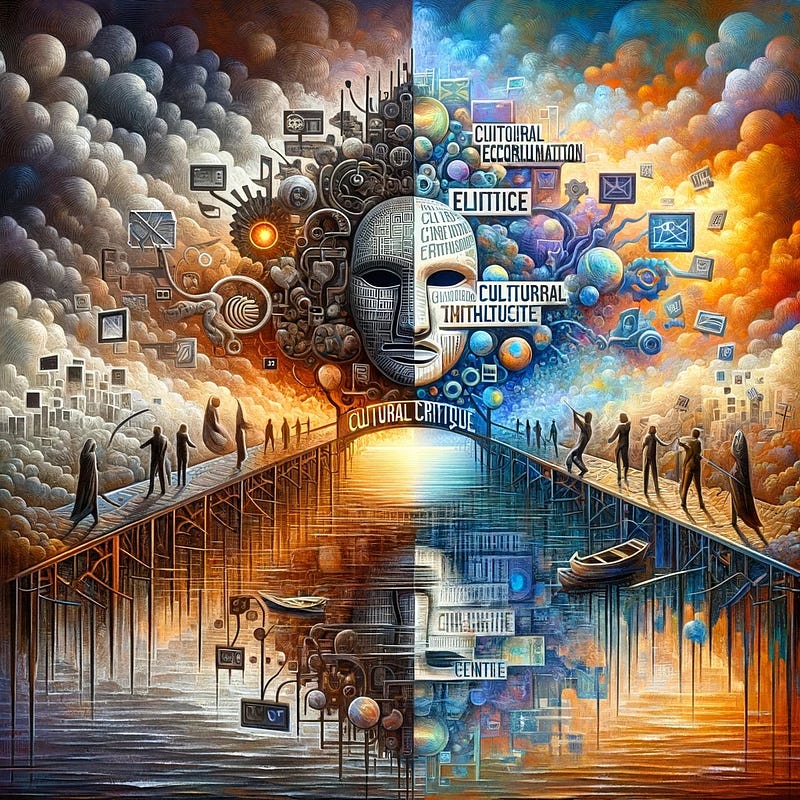Dismantling Power Structures: The Irony of Elite Cultural Critique
Exploring the alienation effect of critique in modern society

Criticism is a form of power. In today’s hyperrealistic world, over-saturated by sterile mass-media facsimiles of art, criticism has become both a form of self-defense and a structure of alienation and dismissive disregard.
In Nicholas Holm’s article Critical capital: Cultural Studies, the Critical Disposition and Critical Reading as Elite Practice, he talks about how being able to critically analyze culture, like movies or books, is often seen as a sign of being well-educated and privileged. That “the mark of education is therefore no longer an affinity for blank verse, but rather a penchant for variants of critical deconstruction” (Holm, 2020, p. 14).
This leads to a world where “artists, authors and content creators across forms and platforms become increasingly aware and alert to the importance of politics to the success of their work” (Holm, 2020, p. 9). This, of course, doesn’t just show itself in the realm of popular culture. In a culture driven by the popular, critical stances align the critic with one side or another along a political spectrum: over here are the elitist progressive liberals, over there are the uncultured authoritarian regressives.
Such distinctions disable our ability to connect with one another, to share appreciation for art and culture. Holm worries that this might make critical thinking seem like something only for the elite, pushing away people who might not have the same educational chances.
What “is thought to divide elites from the common people is no longer high culture, but a critical orientation towards the world that frequently manifests in terms of cultural interpretation” (Holm, 2020, p. 17).
In part, this is also due to the incredibly public and permanent nature of our largest communication medium: the Internet. We can lose jobs for posting our thoughts online, and we can also find ourselves instantly alienated beneath a cancel culture pile-on without even realizing that we’ve trodden on someone else’s lived experience and feelings.
“At its worst,” Holm writes, “critique can become thereby caught up in contests of cultural capital: a competitive endeavour to accrue status within a field by demonstrating one’s facility with political meaning rather than as a means of understanding and transforming the world” (Holm, 2020, p. 17).
What he’s getting at, here, is that the way we can signal our virtue to others has taken on a particular form. If we are aware of the language of criticism, and are able to interpret and use that broad language, we signal our awareness of an issue. We find ourselves caught up in complex cultural lingo for purely the sake of siding with one side or another, distinguishing ourselves as for or against a form of linguistic elitism.
This pace to our communications is part of the problem. Our towns and cities are losing their accessible cultural centers: where else can we go to but the Internet for social dialogue? But the Internet, for all its many splendors, is not a place naturally suited to dialogue. Communication, wrote the physicist David Bohm, “can lead to the creation of something new only if people are able freely to listen to each other, without prejudice, and without trying to influence each other” (Bohm, 1996, p. 3). The Internet, and by extension the whole of our modern socio-cultural existence, is not a place remotely free of prejudice.
Holm puts it eloquently in his article. “Rather than operating as a means to consider and discuss how structures of power shape our cultural consumption, once critique becomes a disposition it can be played as a game: one that manifests in competitive demonstrations of the ultimate unmasking of power that lurks behind texts” (Holm, 2020, p. 17).
There’s an irony in all of this, of course: the language of social criticism labeled by many as “elite” is one designed to dismantle structures of power. But the problem is that, whenever one structure supplants another, new power structures automatically form. Those who are defending themselves against age-old prejudice end up disregarding the oppositional framework of their own criticism, and a cycle of hate manifests itself anew.
This is “why so many reject cultural critique, in its many forms, as an alien and hostile way of understanding the world; because for them, it is not experienced as a good faith form of analysing and understanding the cultural aspects of the world, but rather an indirect mobilization of privilege as a means of domination” (Holm, 2020, p. 18).
If we’re going to alter this paradigm, then both the field of cultural studies and society at large will need to learn to broaden their approaches to cultural critique.
By dismantling barriers and celebrating diverse ways of understanding culture, we can aspire to a society where deep cultural engagement is held as an open opportunity for everyone — regardless of training in, or familiarity with, the lingo of any particular framework of formal critique. But this requires real dialogue in the Socratic and Bohmian sense: not a conversation where polar opposites hammer at one another and attempt to prove this or that point as correct, but an open flow of cultural, social, and emotional exchange where the goal is to reach shared understanding and unified betterment of self and society.
This approach would not only enrich our collective cultural conversations but also ensure they are more representative of diverse experiences and viewpoints.
References
Bohm, D. (1996). On dialogue (L. Nichol, Ed.). Routledge.
Holm, N. (2020). Critical capital: Cultural studies, the critical disposition and critical reading as elite practice. Cultural Studies, 34(1), 143–166. https://doi.org/10.1080/09502386.2018.1549265
